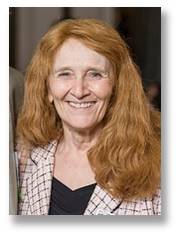
Last week at the Association of Fundraising Professionals International Conference in San Francisco, Janet Brown, the CEO of Grantmakers in the Arts in Seattle and I did another presentation on the proper capitalization of not-for-profit organizations.
Over time, we have expanded our message and were asked to be a part of the Rebels, Renegades, and Pioneers track, a series of seven provocative discussions on the glories, the shortcomings, and the future of the nonprofit world. It was an honor and AFP said, "The speakers featured in this 'conference within a conference' are the innovators, big thinkers, and troublemakers who don’t just think outside the box … they burn the box and scatter the ashes." Well, that's a bit of hyperbole, but it was fun to talk about things that are usually hush-hush in the nonprofit world.
We discussed the need for nonprofits to radically change the way they capitalize their organizations. The presentation was called “Is Your Business Model Broken? The Truth About Fundraising and Capitalization.”
It is essential that we start to build capital reserves and healthy balance sheets into our operating and fundraising assumptions. Planning for financial surpluses and rewarding strong operating reserves is what proper capitalization is all about. We have to fundamentally change how we do business while recognizing that overhead, administration and operating costs DO exist and are part of a vibrant organization. Successful nonprofit organizations have to spend money to make money and to provide their programming.
Just breaking-even at the end of the year does NOT mean success. We DON'T need an endowment if we can't make payroll. It is time to step back and challenge these long-too-held assumptions, challenging how flawed planning, communications, and funding norms perpetuate our broken business models.
Proper capitalization not only allows us to operate day-to-day but gives a chance to take a risk and seize opportunities. It allows us to weather change and recover from the storm. Capital supports acquisitions or upgrades and helps us meet future facility and equipment needs.
Over time, we have expanded our message and were asked to be a part of the Rebels, Renegades, and Pioneers track, a series of seven provocative discussions on the glories, the shortcomings, and the future of the nonprofit world. It was an honor and AFP said, "The speakers featured in this 'conference within a conference' are the innovators, big thinkers, and troublemakers who don’t just think outside the box … they burn the box and scatter the ashes." Well, that's a bit of hyperbole, but it was fun to talk about things that are usually hush-hush in the nonprofit world.
We discussed the need for nonprofits to radically change the way they capitalize their organizations. The presentation was called “Is Your Business Model Broken? The Truth About Fundraising and Capitalization.”
It is essential that we start to build capital reserves and healthy balance sheets into our operating and fundraising assumptions. Planning for financial surpluses and rewarding strong operating reserves is what proper capitalization is all about. We have to fundamentally change how we do business while recognizing that overhead, administration and operating costs DO exist and are part of a vibrant organization. Successful nonprofit organizations have to spend money to make money and to provide their programming.
Just breaking-even at the end of the year does NOT mean success. We DON'T need an endowment if we can't make payroll. It is time to step back and challenge these long-too-held assumptions, challenging how flawed planning, communications, and funding norms perpetuate our broken business models.
Proper capitalization not only allows us to operate day-to-day but gives a chance to take a risk and seize opportunities. It allows us to weather change and recover from the storm. Capital supports acquisitions or upgrades and helps us meet future facility and equipment needs.

It is important that we now elevate knowledge of capitalization for nonprofits. That will require that we build a shared vocabulary to transform our fundraising and financial practices and provide insights into the impact of proper capitalization. For the last six years, Janet Brown and Grantmakers in the Arts has researched how under-capitalization is causing the chronic weakness undermining the vitality of our sector. They have convened organizations in fourteen cities around the country to test their model and emphasize that capitalization IS the means to non-profit success.
The Non-Profit Times were kind enough to do a story on our presentation:
The Non-Profit Times were kind enough to do a story on our presentation:

The Truth About Fundraising and Capitalization
May 2, 2018
Nonprofit sector leaders have fooled themselves into thinking that breaking even at the end of the year means success, or that an endowment is needed in the struggle to pay the bills. It’s time to step back and challenge these long-too-held assumptions, challenge how flawed planning, communications and funding norms perpetuate our broken business models.
The session was headlined “Is Your Business Model Broken? The Truth About Fundraising and Capitalization,” part of the “Rebels, Renegades & Pioneers” track at the AFP International Fundraising Conference with Janet Brown, president and CEO of Grantmakers in the Arts in Seattle, and Brian Bonde, ACFRE, chair of the AFP Foundation for Philanthropy and president of Advanced Certified Fundraising in Sioux Falls, S.D.
They explained that proper capitalization not only allows you to operate day-to-day but also gives you a chance to take a risk and seize opportunities. “It allows you to weather change and recover from the storm. Capital supports acquisitions or upgrades and helps you meet future facility and equipment needs,” they say.
Brown and Bonde advised that it is time to unabashedly build capital reserves and healthy balance sheets into your operating and fundraising assumptions. “Planning for financial surpluses and rewarding strong operating reserves is what proper capitalization is all about,” they pointed out. “You can fundamentally change how you do business while recognizing that successful nonprofit organizations do have overhead, administration and operating costs.”
Furthermore, it is important that knowledge of capitalization for nonprofits now be elevated. “This will require that you build a shared vocabulary to transform your fundraising and financial practices and provide insights into the impact of proper capitalization,” Brown added.
For example, for the past six years, Grantmakers in the Arts has researched how undercapitalization is causing the chronic weakness undermining the vitality of the nonprofit sector. They have convened organizations in 14 cities around the country to test their model and emphasize that capitalization is the means to success.
May 2, 2018
Nonprofit sector leaders have fooled themselves into thinking that breaking even at the end of the year means success, or that an endowment is needed in the struggle to pay the bills. It’s time to step back and challenge these long-too-held assumptions, challenge how flawed planning, communications and funding norms perpetuate our broken business models.
The session was headlined “Is Your Business Model Broken? The Truth About Fundraising and Capitalization,” part of the “Rebels, Renegades & Pioneers” track at the AFP International Fundraising Conference with Janet Brown, president and CEO of Grantmakers in the Arts in Seattle, and Brian Bonde, ACFRE, chair of the AFP Foundation for Philanthropy and president of Advanced Certified Fundraising in Sioux Falls, S.D.
They explained that proper capitalization not only allows you to operate day-to-day but also gives you a chance to take a risk and seize opportunities. “It allows you to weather change and recover from the storm. Capital supports acquisitions or upgrades and helps you meet future facility and equipment needs,” they say.
Brown and Bonde advised that it is time to unabashedly build capital reserves and healthy balance sheets into your operating and fundraising assumptions. “Planning for financial surpluses and rewarding strong operating reserves is what proper capitalization is all about,” they pointed out. “You can fundamentally change how you do business while recognizing that successful nonprofit organizations do have overhead, administration and operating costs.”
Furthermore, it is important that knowledge of capitalization for nonprofits now be elevated. “This will require that you build a shared vocabulary to transform your fundraising and financial practices and provide insights into the impact of proper capitalization,” Brown added.
For example, for the past six years, Grantmakers in the Arts has researched how undercapitalization is causing the chronic weakness undermining the vitality of the nonprofit sector. They have convened organizations in 14 cities around the country to test their model and emphasize that capitalization is the means to success.
 RSS Feed
RSS Feed
